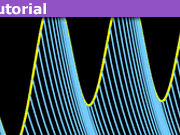Learn Further Sums Found Through Fourier Series
In an earlier insight, I looked at the Fourier series for some simple polynomials and what we could deduce from those series. There is a lot more to be found, however.
Table of Contents
Evaluating the Fourier series at π/2
First series
In the last insight, I showed that if f(x) = x for -π<x<πand f(-π)=f(π)=0, the general term of the series was [itex]a_{n}=\frac{(-1)^{n}}{in}[/itex] with [itex]a_{0}=0[/itex]. Since f(x) is differentiable at π/2, the Fourier series converges at that point, giving [tex]\frac{\pi}{2}=\sum_{n=-\infty}^{-1}\frac{(-1)^{n}}{in}e^{in\frac{\pi}{2}}+0+\sum_{n=1}^{\infty}\frac{(-1)^{n}}{in}e^{in\frac{\pi}{2}}[/tex]
Changing n to –n in the first sum, we get[tex]\frac{\pi}{2}=\sum_{n=1}^{\infty}\frac{(-1)^{n}}{-in}e^{-in\frac{\pi}{2}}+\sum_{n=1}^{\infty}\frac{(-1)^{n}}{in}e^{in\frac{\pi}{2}}[/tex]
Now [itex]\frac{e^{inx}-e^{-inx}}{2i}=\sin(nx) [/itex] and therefore [itex] \frac{\pi}{2}=2\sum_{n=1}^{\infty}\frac{(-1)^{n}}{n}\sin(\frac{n\pi}{2})[/itex]. Since [itex]\sin(\frac{n\pi}{2})[/itex] is 0 for all even multiples of p/2 and alternating between +1 and -1 for odd multiples, we have [tex]\frac{\pi}{4}=\sum_{n=1}^{\infty}\frac{(-1)^{n-1}}{2n-1} [/tex]
Not exactly a new result, it is usually known as Leibniz’ formula, but it shows that our calculations are correct.
A bit more unusual: The result can also be written as [itex]\frac{\pi}{2}=\sum_{n=1}^{\infty}\frac{(-1)^{n-1}}{n-\frac{1}{2}}[/itex]. Compare this result with the well-known fact that [itex]\sum_{n=1}^{\infty}\frac{(-1)^{n-1}}{n}=\ln(2)[/itex]…
Second series
In the last insight, I used f(x) = x2 for -π≤x≤π. The general term was then [itex]a_{n}=\frac{2}{n^{2}}[/itex] with [itex]a_{0}=\frac{\pi^{2}}{3}[/itex]. Inserting x=π/2 gives [tex]\frac{\pi^{2}}{4}=\sum_{n=-\infty}^{-1}\frac{2}{n^{2}}e^{in\frac{\pi}{2}}+\frac{\pi^{2}}{3}+\sum_{n=1}^{\infty}\frac{2}{n^{2}}e^{in\frac{\pi}{2}}[/tex]
Change n to –n in the first sum and reorder: [tex]\frac{\pi^{2}}{4}-\frac{\pi^{2}}{3}=\sum_{n=1}^{\infty}\frac{2}{n^{2}}e^{-in\frac{\pi}{2}}+\sum_{n=1}^{\infty}\frac{2}{n^{2}}e^{in\frac{\pi}{2}} [/tex]
Now [itex]\frac{e^{inx}+e^{-inx}}{2}=\cos(nx)[/itex] and therefore [tex] \frac{-\pi^{2}}{12}=4\sum_{n=1}^{\infty}\frac{1}{n^{2}}\cos(\frac{n\pi}{2})[/tex].
Since [itex]\cos(\frac{n\pi}{2})[/itex] is 0 for all odd multiples of π/2 and alternating between +1 and -1 for even multiples, we have [tex]\frac{-\pi^{2}}{48}=4\sum_{n=1}^{\infty}\frac{(-1)^{n}}{n^{2}} [/tex]
Change sign and reorder: [tex]\sum_{n=1}^{\infty}\frac{(-1)^{n-1}}{n^{2}}=\frac{\pi^{2}}{12} [/tex]
Again, a known fact, but it verifies our procedure.
Staying with the inverse squares, let us try a slightly more unusual function.
Let f(x) be periodic with period 2π where f(x) = cosh(x) for -π≤x≤π. Then [tex]a_{n}=\frac{1}{2\pi}\int_{-\pi}^{\pi}\cosh(t)e^{-int}dt=\frac{1}{2\pi}\int_{-\pi}^{\pi}\frac{1}{2}(e^{t}+e^{-t})e^{-int}dt[/tex][tex]=\frac{1}{4\pi}\int_{-\pi}^{\pi}(e^{t-int}+e^{-t-int})dt[/tex][tex]=\frac{1}{4\pi}(\frac{1}{1-in}(e^{\pi-in\pi}-e^{-\pi+in\pi})-\frac{1}{1-in}(e^{-\pi-in\pi}-e^{\pi+in\pi})) [/tex]
Remembering that [itex]e^{-in\pi}=e^{in\pi}=(-1)^{n}[/itex], we have [tex]a_{n}=\frac{1}{4\pi}(\frac{1+in}{1+n^{2}}(-1)^{n}(e^{\pi}-e^{-\pi})-\frac{1-in}{1+n^{2}}(-1)^{n}(e^{-\pi}-e^{\pi})[/tex][tex] =\frac{(-1)^{n}}{2\pi}(\frac{1+in}{1+n^{2}}(-1)^{n}\sinh(\pi)+\frac{1-in}{1+n^{2}}(-1)^{n}\sinh(\pi))[/tex][tex]=\frac{(-1)^{n}}{\pi}(\frac{\sinh(\pi)}{1+n^{2}}) [/tex]
For n=0 we have [tex]a_{0}=\frac{1}{2\pi}\int_{-\pi}^{\pi}\cosh(t)dt=\frac{1}{2\pi}(\sinh(\pi)-\sinh(-\pi))=\frac{\sinh(\pi)}{\pi} [/tex]
Thus [tex]\cosh(x)=\sum_{n=-\infty}^{-1}\frac{(-1)^{n}}{\pi}\frac{\sinh(\pi)}{1+n^{2}}e^{inx}+\frac{\sinh(\pi)}{\pi}+\sum_{n=1}^{\infty}\frac{(-1)^{n}}{\pi}\frac{\sinh(\pi)}{1+n^{2}}e^{inx}[/tex][tex] =\frac{\sinh(\pi)}{\pi}(1+\sum_{n=1}^{\infty}\frac{(-1)^{n}}{1+n^{2}}(e^{inx}+e^{-inx}))[/tex]
For this tells us (the convergence of the series is trivial) that[tex] \cosh(\pi)=\frac{\sinh(\pi)}{\pi}(1+\sum_{n=1}^{\infty}\frac{2}{1+n^{2}}[/tex]
Reordering this expression, we get [tex] \sum_{n=1}^{\infty}\frac{1}{n^{2}+1}=\frac{1}{2}(\pi\coth(\pi)-1)[/tex]
If we evaluate the series for [itex]x=0[/itex] instead, we get [tex]\cosh(0)=1=\frac{\sinh(\pi)}{\pi}(1+\sum_{n=1}^{\infty}\frac{2\cdot (-1)^{n}}{1+n^{2}}[/tex]
Reordering this expression, we get [tex]\sum_{n=1}^{\infty}\frac{(-1)^{n}}{1+n^{2}}=\frac{1}{2}(\frac{\pi}{\sinh(\pi)}-1) [/tex]
Adding 1 to both sides of the expression, we get[tex]\sum_{n=0}^{\infty}\frac{(-1)^{n}}{n^{2}+1}=\frac{1}{2}(\frac{\pi}{\sinh(\pi)}+1) [/tex]
Third series
In the last insight, I used f(x) = x3-π2x. Here I will just change the sign and use [itex]f(x)=\pi^{2}x-x^{3}[/itex]. It will, of course, change the sign of the calculated coefficients, so [itex]a_{n}=\frac{-6}{in^{3}}[/itex] with [itex] a_{0}=0[/itex]. Inserting x=π/2 gives [tex] \frac{\pi^{3}}{2}-\frac{\pi^{3}}{8}=\sum_{n=-\infty}^{-1}\frac{-6}{in^{3}}e^{in\frac{\pi}{2}}+\sum_{n=1}^{\infty}\frac{-6}{in^{3}}e^{in\frac{\pi}{2}}[/tex]
Reordering: [tex]\frac{\pi^{3}}{16}=\sum_{n=1}^{\infty}\frac{1}{in^{3}}e^{-in\frac{\pi}{2}}+\sum_{n=1}^{\infty}\frac{-1}{in^{3}}e^{in\frac{\pi}{2}} [/tex]
Again, we have a sine function, so [tex] \frac{\pi^{3}}{32}=\sum_{n=1}^{\infty}\frac{(-1)^{n-1}}{(2n-1)^{3}}[/tex]
Reducing the denominator: [tex] \sum_{n=1}^{\infty}\frac{(-1)^{n-1}}{(n-\frac{1}{2})^{3}}=\frac{\pi^{3}}{4}[/tex]
These results may be new, I do not know (I certainly have not seen them before).
Read my next article: Why Road Capacity Is Almost Independent of the Speed Limit
Master’s in Mathematics, Norway. Interested in Network-based time synchronisation.






Оформление второго гражданства за границей становится всё более востребованным среди граждан РФ.
Такой статус предоставляет новые возможности для работы и бизнеса.
Второй паспорт помогает свободнее передвигаться и получать доступ к другим странам.
Кроме того подобное решение может улучшить финансовую стабильность.
Адвокат в Ирландии
Многие россияне рассматривают возможность переезда как способ расширения возможностей.
Оформляя ВНЖ или второй паспорт, человек может инвестировать за рубежом.
Разные направления предлагают индивидуальные возможности получения вида на жительство.
Именно поэтому идея второго паспорта становится приоритетной для тех, кто планирует развитие.
Did you notice that Mathematica disagrees on the sign of the last one?No, saw it just now. Mathematica is correct, the correct exponent for (-1) should be (n-1), not n.
Then Mathematica and I agree. Fine!
For me this is part of the road I am currently going. As long as I am getting correct answers along the way, I am happy.Did you notice that Mathematica disagrees on the sign of the last one?
Mathematica gave this:Then Mathematica and I agree. Fine!
For me this is part of the road I am currently going. As long as I am getting correct answers along the way, I am happy.
Mathematica gave this:
View attachment 213068
Quick Latex pointer: if you write "left(" and "right)" instead of "(" and ")" you get parentheses which self-adjust their height.